C.B. Bhattacharya's Blog: Small Actions Big Difference, page 2
October 14, 2021
Teaching Sustainability to the Next Generation
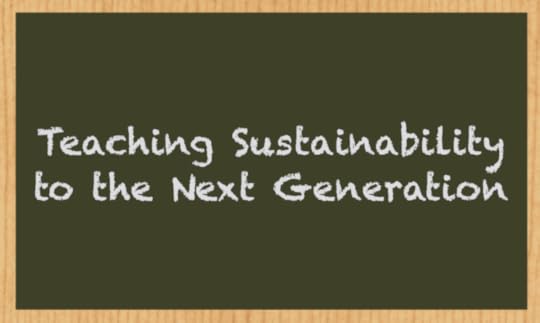 For Tomorrow’s Consumers and Creators
For Tomorrow’s Consumers and Creators My last article ended on what I believe to be one of the most important and relevant topics of today: how can we teach the next generation about climate change? Children and young adults of all ages must realize that the biggest challenge their generation will face is climate change. From our side, giving them the tools and knowledge necessary to prepare them for this battle is not only our responsibility, but also a part of our generation’s battle against climate change. It is estimated that the Earth’s population will reach close to 10 billion by 2050; the problems surrounding resource allocation will get even worse if we do not start teaching the next generation of consumers and leaders to be more conscious about how they live their lives or conduct their businesses.
But where do we start? First, let’s categorize the current generation of students: we have those from kindergarten to 6th grade, 7th grade to 12th grade, and, finally, college students. Those are the brackets I chose simply due to vast differences in the responsibilities, worldly knowledge, and future goals they all possess. For example, a college student might be looking for a job, while a high schooler is searching for a major/college. We need to design curriculums and initiatives that not only align, but also support the development of a child from one bracket to the next.
Primary Education: #BeNicetothePlanet
We teach young children how to be kind to one another, but let’s also teach them how to be kinder to the planet. We don’t need to tell the kids about carbon emissions and their footprint or ESGs and CSRs. Instead, let’s teach them about the beauty of this planet and ask them what they already know. Let’s tell them about how their everyday decisions, that may be small for us, but are big for them, have an actual impact on this planet. Between the ages of 5-12, a complex problem like climate change needs to be explained gradually, as their knowledge increases. Keeping young children engaged is difficult, but there are a ton of things a parent or educator can do: from field trips to the museum/science center to challenges that get them excited to learn more about their planet. Through this, we have laid the foundation for what is to come next.
Secondary Education: #ThinkBetterforthePlanet
We talked about introducing the planet and its many wonders to young children. Now, it’s important to start teaching teens about the issues at hand. Between the ages of 13-18, students start taking more complex subjects within the broader categories of math, science, social studies, and more, so why not integrate sustainability? Since they already have a foundation for the basics, integrating lessons into the existing curriculum surrounding the past, present, and the future of climate change and the science behind it all should be at the top of every school board’s agenda, if it isn’t already. Parents and educators that are frustrated by the constraints of board and state government politics surrounding the current curriculum need to speak up.
We are also giving these teens a head start outside of their classrooms; their lessons surrounding sustainability will hopefully trickle into their everyday habits and thoughts, some that will stick with them for the rest of their lives. Now, to the last stop.
College Students: #DoBetterforthePlanet
Many colleges and universities across the globe have taken an important leap by starting up their own centers and departments for sustainability; some have even started to offer classes and degrees in relevant fields. Yet, there is a lot more to be done: e.g., an economics class teaches about profit maximization, but what about wealth maximization? Analyzing sustainability reports? Uncovering modern slavery tactics used by large corporations? We must realize that we’re teaching these young adults who are on verge of joining the global workforce about how to do one thing and one thing only: generating the highest profit for their companies. That is not a lofty or even a worthwhile goal. It’s time we start teaching them about the purpose of business in society, the triple bottom line and how that surprisingly (or not surprisingly) will have an even better impact for their companies.
Those that fit into this age bracket also need to start taking things into their own hands; things like taking classes on platforms like EdX, Udemy, etc., all of which offer courses relevant to sustainability. They also need to seek employment in companies or organizations that are trying to make a change or a starting business that has sustainability running through its veins, which in turn can provide employment for those that have similar ideologies.
Our generations’ responsibility is to guide those that are yet to begin, or support those that are already on the path towards becoming more conscious consumers and creators. To secure the future for those that are inheriting this planet from us, we must make such responsibility our priority as parents, educators, and mentors.
“Unless we are willing to encourage our children to reconnect with and appreciate the natural world, we can’t expect them to help protect and care for it.”
– David Suzuki
ABOUT SMALL ACTIONS BIG DIFFERENCE
Based on interviews with 25 global multinational corporations as well as employees, middle managers, and senior leaders across multiple sectors, this is the first book to connect sustainability to the theory and principles of psychological ownership and to propose a succinct, easy-to-digest model of managerial use.
ABOUT CB SUITE
This fortnightly knowledge byte series is an effort to simplify the understanding of sustainability and share insights that help actively be part of building a future that is just, equal and sustainable for all.
September 28, 2021
Is Climate Change Already Irreversible?
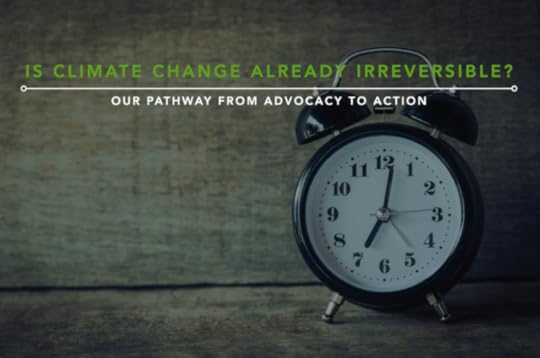
“The world is on a catastrophic pathway.” These were the words of António Guterres, the Secretary General of the United Nations, after the UN released a devastating report which stated that by the end of the century, the global average temperature will rise by 2.7 degrees Celsius even if every country met their emissions goals. Climate change has obviously moved beyond debate, but has that point really sunk in? Climate talks at the aforementioned UN General Assembly indicated that although world leaders have made progress on spending more money on controlling climate change, there seem to be no corresponding drastic measures taken on cutting emissions. So, solely relying on our governments to do all the heavy lifting seems like a pipe dream.
This is an opportunity for companies and consumers to come together and build a pathway to turn climate change rhetoric into action. It’s not like this hasn’t been done in other spheres. Over the past few years, many brands have embraced political and cultural statements made by their stakeholders, which helped move forward the conversation and subsequent actions surrounding topics such as the #MeToo movement and Black Lives Matter.
Before any action is taken, it is important for both companies and consumers to understand that it takes two to tango. And climate change is a complex issue that requires us to learn from our past patterns and consider varied perspectives. So where do companies start? And what role do consumers play?
1. Companies can start by facilitating #NoChoiceOptions
Part of the problem stems from how companies can get away with little to no backlash for providing misinformation surrounding their products’ origin or recyclability. As consumers, we need to ask, or even fight, for standards to be put in place that would allow for us to become informed decision makers. Did you know that even if a plastic product has the recycle logo, it doesn’t imply that the product can be recycled. Brands that claim to be manufacturing recyclable products need to start taking responsibility for the afterlife of a product. Campaigns and initiatives like showing what a plastic bottle can become if recycled and promoting product stewardship are steps in the right direction. Companies can also facilitate no choice options by giving their consumers no option but sustainably sourced, produced, and packaged goods. Now that is a tall order, but if there is a demand, then there is no reason for brands not to respond.
2. Consumers need to #MakeitPersonal
Though a majority of consumers say that they want to purchase sustainable and ethical products, when it comes time to talk with their wallets, they become eerily quiet. Customers need to realize that as bystanders, they’re not taking this societal and climatic challenge personally. Increasing awareness and knowledge surrounding the true cost of product ownership is vital for consumers to realize that their purchases have more than just monetary value. Unilever estimates that 70% of its own greenhouse gas footprint depends on what consumers do with their products. Individual ownership of this challenge can be advanced only if a consumer can clearly connect their present behavior and choices to their future outcomes. Elke Weber’s research on attitudes towards climate change establishes that human beings have a “finite pool of worry”. One way to consciously integrate sustainability into our lifestyles, or “our pools of worry”, is by using the power of social influence and competition. As humans, we inherently respond to emotional appeals laden with social identity, so this is where companies can help us embrace and believe that being sustainable is desirable, “or cool”. Look at how Patagonia has made conscious consumerism fashionable with their famous Black Friday campaign on the front page of the New York Times.
Yet, this only tells us what we, the current generation of consumers, can do. What about the next generations?
3. We must #PassitOn
Fighting climate change is more than just saving the environment for our well-being. It’s about leaving behind a better world for the future generation of consumers, producers, and leaders. And there is an overwhelming majority of parents and teachers that support teaching the future generation of “customers” about climate change, but no progress is being made primarily because it isn’t a part of the curriculum. We are not trying to frighten children, but we must inform them of our current predicament. Teaching kids from a young age about how to be environmentally conscious and ethical decision makers will not only help them become better consumers, but also better producers and leaders. And in turn, education surrounding sustainability in the classroom could soon trickle into conversations at home where children influence their parents’ decision making.
If we all take one small step in the right direction, we are collectively moving our society towards taking individual ownership of this challenge. We will have to focus on the silver linings, turn risks into opportunities, and understand that change takes time, but all of this is only relevant when we can turn rhetoric into action. We need to act on our words if we wish to leave no one behind.
You can also subscribe to my fortnightly newsletter series and have direct access to green insights in your inbox.
Follow the link to sign up now
ABOUT SMALL ACTIONS BIG DIFFERENCE
Based on interviews spanning 25 global multinational corporations and 100+employees, middle managers, and senior leaders across multiple sectors, this is the first book to connect sustainability to the theory and principles of psychological ownership and to propose a succinct, easy-to-digest model of managerial use. Buy the book here.
ABOUT CB SUITE
This fortnightly knowledge byte series is an effort to simplify the understanding of sustainability and share insights that help everyone be part of building a future that is just, equitable and sustainable for all. More at thecbsuite.com
June 30, 2021
How to tackle the purpose gap and increase employee engagement
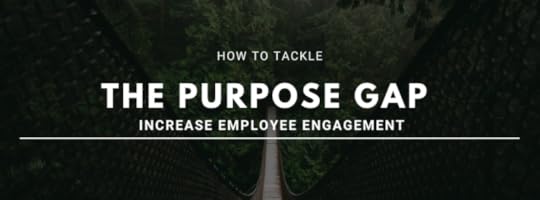
By now we know that the key to building a vibrant and sustainable company is to get everyone from top executives to assembly line workers engaged in everyday corporate sustainability efforts. However, even as companies come to terms with the philosophy and culture of purpose – the answer to the all-important question of “why we do what we do” — more often than not, most companies fail to bring purpose to life for their employees and other stakeholders. As the gap between the rhetoric of a purpose statement and the urgency to activate it grows, that of consumer cynicism becomes darker. Sustainability – which jumps out as a priority when the purpose is clearly defined and brought to life – has to be more than just a buzzword; it has to become a practice and a responsibility of every stakeholder. To that end, the purpose is the North Star.
Purpose is not a mere tagline or marketing campaign; it is a company’s fundamental reason for being – what it does every day to create value for its stakeholders – Larry Fink, BlackRock CEO
Too often, when purpose is treated as a marketing or HR project, it fails to connect with employees. As a result, employees and executives believe that companies are not doing enough to instill a sense of purpose.
As COVID restrictions start to ease out and boardrooms that once looked like war-zones prepare to build back better, the question is – what should the new normal look like? How do we now define principles that guide development of purpose thus outlasting the systemic damage endured over this period of time?
To lead employees to their purpose epiphanies and unlock barriers that prevent its implementation, I base my sustainability ownership framework on three key principles:
#1 Nudge the root driver to activate purpose
Having purpose is the result of rethinking why a company does what it does. All, or at least most companies, provide customers with a societal benefit which must be clearly articulated and cascaded internally. Embedding corporate ambition in an employee’s DNA requires leaders to engage employees beyond intellectual, strategic engagement, and base the relationship on an emotional link (i.e., sustainability ownership) with the organization. The objective should neither be to impose a strict strategic agenda nor to inspire employees towards a staggering goal, but rather should give the employee freedom or autonomy to interpret the broad objectives and creatively align the employees’ personal values to the company’s purpose.
I recall that while teaching executives at KOC University in Istanbul, Turkey, a young man having trouble with the concept of purpose in the context of his company said … they only thought about making money. When I asked him where he worked, he said he worked for an automobile spare parts manufacturer. As we brainstormed in class, it started becoming clearer that the proper functioning of the part helped prevent cars from breaking down thus helping people avoid distress… the actual purpose of the company. One of the preconditions for sustainability ownership is that people can get behind what to own – the object or idea has to be personally appealing, meaningful and desirable to begin with. Purpose trumps profit every time in this regard!
A well-defined purpose that views the company as providing a service to society has morality embedded into it.
#2 Build sustainability ownership by using principles of psychology
Employees don’t just want to work for a company. They want to belong to an organization
Three key human motivations are efficacy, self-identity and belonging; these fuel desire to target and own something. As humans all of us want to leave our mark, express our identities and find a sense of belonging. Structuring sustainability ownership by giving tangible and creative opportunities to achieve sustainability goals helps inject meaning, security and comfort, enabling the crucial shift in mindset required to take such ownership. Sustainability ownership offers employees a chance to express themselves and be part of something larger than themselves and the organization. A former Unilever executive, once told me about a global handwashing program launched around the anti-bacterial soap Lifebuoy to teach children the benefits of simple hygiene, which, thanks to the active work done by their employees to spread the message, gradually transitioned its brand purpose to being institutionalized as a public policy initiative. That’s a veritable win-win for all! It’s thus important to incubate ownership and galvanize action by sowing the core message of a company’s purpose and truly walk the talk. Move beyond just advocating for #ClimateAction and the other SDG’s and really act.
#3 Lead by example to build a purpose-driven company
A leadership committed to a higher business purpose and one that drives employee ownership of sustainability – that is the difference between the best and the rest. Driving purpose requires strong leadership; purpose must be defined and lived from the top. While the mission, vision or value statement of a company constitutes the traditional motivation toolbox, purpose goes a step further by combining reason and passion, left brain and right, head and heart. Sometimes business transformation initiatives with an eye on the future remain meaningless to employees, particularly if they believe that such transformation is in the quest for profits alone. Clearly expressing purpose and tying it to the societal benefit offered by the company makes one’s job meaningful and inspires employees to take ownership of sustainability.
“Every Ship needs a good captain, especially when there’s a storm and the sailing get rough. So, it starts with a firm commitment from the CEO” – Paul Polman
Although achieving acceptable financial objectives is clearly important for a company’s survival, it rarely galvanizes action. If people are to put in extraordinary effort, they must be able to identify with the underlying reason. Leaders that are able to infuse the work of their employees with purpose are nothing short of transformational. As effective as clear verbal communication can be, it is essential to understand that purpose is really best communicated by action. Leadership by example is key. Moreover, journeys and goals are never static and thus it is important to check periodically if employees still understand and live by the original purpose. If they don’t, then it’s important that leadership finds out if communication – in word or deed – is at fault – and take necessary corrective action.
For net-zero targets to succeed, employee engagement and sustainability ownership is paramount. We no more have the time to walk our way to our targets; it’s time we run the Race to Zero and move beyond mere advocacy. It’s important for us to link everyone’s journey to their personal aspirations in order to ensure sustainability becomes a way of doing business. The larger concern of execution will only be addressed if we authentically align with social and environmental causes and not just want people to work from paycheck to paycheck.
Our time to be the change is here, whether we pick up the baton or not is up to us.
You can also subscribe to my fortnightly newsletter series and have direct access to green insights in your inbox.
Follow the link to sign up now
ABOUT SMALL ACTIONS BIG DIFFERENCE
Based on interviews spanning 25 global multinational corporations and 100+employees, middle managers, and senior leaders across multiple sectors, this is the first book to connect sustainability to the theory and principles of psychological ownership and to propose a succinct, easy-to-digest model of managerial use.
ABOUT CB SUITE
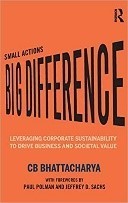
This fortnightly knowledge byte series is an effort to simplify the understanding of sustainability and share insights that help everyone be part of building a future that is just, equitable and sustainable for all.
More at https://thecbsuite.com
Companies must rethink the role of competition in the context of sustainability
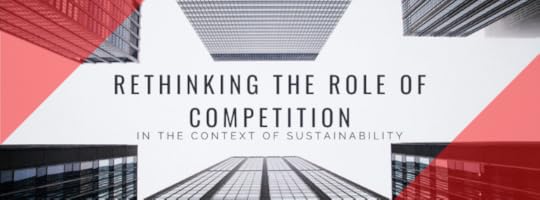
Until recently, most executives laughed at the idea of collaborating with competitors to drive change. However, if there is anything that the global healthcare crisis, economic slowdown, and environmental distress have taught us, it is that
“No one is safe until everyone is safe”-Deputy secretary-general Amina Mohammed, United Nations
Collective ownership is an important step on the journey of de-individualizing sustainability and co-managing the bigger problems faced by the earth, its population, people, and businesses. Starting with purpose and building a collective response strategy lets everybody gain, thus combating the “tragedy of the commons”.
But if the benefits of collaboration are so clear, why do companies find it so difficult to collaborate? What is it that needs to be done to help rethink the role of competition?
1 Build a foundation of confidence and openness
Companies large or small can come together to address problems of scale – once reserved for the attention of governments –to conceive solutions with a cross-industry perspective. Such a strategy requires close investigation of the entire value chain drivers and interorganizational cooperation.
We must be prepared to let the outside world in.

An excellent example of one such collaboration addresses the sourcing of conflict minerals which include raw materials Gold, Tungsten, Tantalum, and Tin which are sourced from militia-controlled mines in the troubled Democratic Republic of Congo. Responsible Minerals Initiative is an industry-wide collaboration designed to help its 400 member companies make responsible sourcing decisions and improve regulatory compliance while sourcing minerals from these conflict-affected and high-risk areas.
No single business purchases enough volume to shift the market alone– Mike Barry
#2 Start with trust, integrity, and honest analysis of existing capabilities
Real work in this area requires intellectual energy, management time, and a mindset shift from the old paradigm where competitors are viewed as enemies to them being allies in a greater cause that demands collective ownership to yield collective benefits for a healthy planet.
It was only when Greenpeace asked Adidas if they were testing wastewater at their suppliers, did leaders at Adidas confess that they did not have a clue. Seven years after the launch of “Detox my Fashion” campaign by Greenpeace, companies representing around 15% of global clothing production have made significant progress in phasing out chemicals from their production-lines. A tough industry wide response that was equally troublesome and gruelling started with mutual trust and honest analysis with a vision to collectively move existing risks into opportunities.
If we all do it then our industry survives – because if our industry goes down the drain, we can be a good company, but we will also go down the drain. So we need to have a collective approach to this – Sr Corporate executive
#3 Identify a non-corporate entity that acts as a neutralizer
Long established rivalries, different cultures, and even anti-trust issues make it much safer to meet on a neutral ground provided by a facilitator. When UK’s major food retailers met at a University engineering department to talk about reducing emissions that are released when manufacturing the materials for shops or when fitting out retail units, the catalyst to opening up to competitors was the decision to meet on neutral ground with a neutral facilitator and putting sustainability in a pre-competitive space.
The issues we face are so big and the targets are so challenging that we cannot do it alone. When you look at any issue, such as food or water scarcity, it is very clear that no individual institution, government, or company can provide the solution-Paul Polman, Founder IMAGINE, former CEO Unilever
However, it is important to consider if a private forum with a neutralizer is the best way to bring every organization and all those different goals and ideas together. Often, increased corporate awareness and the drive to meet “higher purpose” has seen formations of groups such as the Consumer Goods Forum where companies can opt to join subgroups dealing with deforestation, reforestation, waste, environmental impact measurement, etc. that can help tackle the issue. Thus, identifying an appropriate pathway should be done only after close investigation of the issues that the company aims to tackle.
True leadership in turbulent times is about having the vision and fortitude to establish a new normal. The only way we can foster change on the scale required is to take collective ownership of and share responsibility for the planet and its future.
ABOUT SMALL ACTIONS BIG DIFFERENCE
Based on interviews with 25 global multinational corporations as well as employees, middle managers, and senior leaders across multiple sectors, this is the first book to connect sustainability to the theory and principles of psychological ownership and to propose a succinct, easy-to-digest model of managerial use.
This fortnightly knowledge byte series is an effort to simplify the understanding of sustainability and share insights that help actively be part of building a future that is just, equal and sustainable for all.
What are Benefit Corporations and should your company become one?
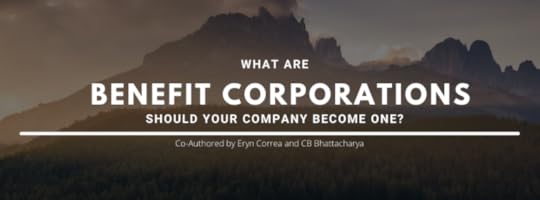
If Boeing had placed stakeholder values at the core of its business, would it be in the position it is today? We will never know if Boeing could have avoided the 737 Max catastrophes had it been a benefit corporation. Regardless, the system of shareholder primacy is ripe for change. It is time to stop hoping corporate leaders act like human beings and instead, require that they do.
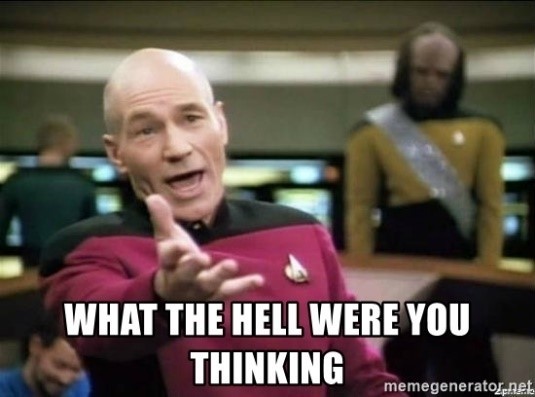
Throwback to November 18, 2020 when Boeing received clearance from the Federal Aviation Administration that its 737 Max could resume flight in American skies. While redesigns and pilot trainings are important steps, this plane should not return to the air until shareholder primacy, the systemic flaw in the way corporate leaders make decisions, is addressed.
Benefit corporations are legal entities that, if widely adopted, could change the corporate decision-making paradigm. Benefit corporation law mandates that corporate leaders adopt a stakeholder approach to decision-making: where corporations consider the impact of their decisions on consumers, employees, the environment, the community, and greater society, in addition to the shareholders. Under benefit corporation law, the system of decision-making would no longer pit a corporate leader’s humanity against her duty to her shareholders. Instead, those duties, ideally, would align with those of shareholders and society. However, becoming a benefit corporation is not without its challenges and the decision whether to become one should be carefully considered.
But – What does it even mean? A “benefit corporation” is a legal entity like a C-corporation or a limited liability company (LLC) that establishes a legal framework for mission-driven companies. To date, thirty-eight states, including Delaware, have adopted benefit corporation legislation and companies such as Patagonia, Kickstarter, and King Arthur Flour are structured as benefit corporations pursuant to the legislation.
Benefit corporation law requires corporate leaders to consider the impact of their decisions on all stakeholders. This means that when a corporate leader is presented with a decision, they are not duty-bound to favor the decision that maximizes shareholder returns. Had Boeing been a benefit corporation, it means that Mr. Muilenburg would have been required to pay attention to emails about his exhausted employees or persistent safety concerns; his employees and the consumers, under benefit corporation law, would all be stakeholders to whom he owed a legal duty.
Moreover, benefit corporation law requires greater corporate accountability. A benefit corporation must be organized for the purpose of creating a “general public benefit” (and/or specific public benefits that are tailored to the business and operations of the corporation) and allows shareholders to bring suit when that purpose is not being met.
Why should a Corporation Become a Benefit Corporation?
Benefit corporation law is voluntary, meaning no corporation is required to act by the mandates of the law unless they so choose.
Many investors may not be interested in the idea that their interests are placed on par with other considerations and either refuse to invest or jump ship. In addition, benefit corporations are a new type of corporate entity that are yet to be tested in court, leaving this entity open to legal uncertainty. Furthermore, benefit corporation law allows for expanded corporate liability in allowing shareholders to sue for failure of the company to pursue its general public benefit. This is in addition to corporate suits already available to shareholders. Finally, being a benefit corporation comes with potentially heightened reputational risk. Missteps currently considered commonplace would likely invite greater public ire when coming from a company that promised to be a more responsible corporate steward.
That said, emerging evidence shows that a stakeholder approach to decision making generates significantly better financial returns, albeit in the long-term. Companies that place stakeholder values at the core of their business consistently and significantly outperform the S&P 500 and experience less volatility during crisis times such as the COVID-19 pandemic. Additionally, these companies enjoy greater employee engagement because they attract people who are committed to the mission and are dedicated to realizing it. Corporations that have the ability to ride out the growing pains could see their bottom line strengthened as a result.
The question of whether to become a benefit corporation is dependent on several factors.
#1 Stage of Development
Corporate leaders should first consider their stage of development. A not-yet-incorporated entity can easily choose to be a benefit corporation, often times by checking a box on the relevant state’s incorporation form.
A corporation that is already formed will face additional hurdles in becoming a benefit corporation. Most states require a super-majority vote of the corporation’s shareholders to convert an existing corporation into a benefit corporation. This requirement is meant to protect shareholders, who, in voting to become a benefit corporation would be sacrificing their primary status. Larger, publicly-traded corporations would additionally need to take into consideration the stance of institutional investors and, more broadly, public opinion and the impact of such action on their stock price. And all corporations, regardless of their development stage, would incur legal fees in drafting or amending their respective governance documents to conform to the laws’ requirements.
#2 Available Resources
Similar to the stage of development, corporate leaders should take a look at their available resources. Once incorporated, governing a benefit corporation requires dedication. This may include creating a separate committee of the board of directors to manage the corporation’s expanded duties, creating a specific management role or new department, reviewing and/or drafting additional internal policies, and otherwise constructing a new framework for making decisions. Corporations in earlier stages of development may not have the resources to allocate to the maintenance of this kind of entity, nor may further-developed corporations have the desire to reorganize their system of decision-making so drastically.
#3 Risk Appetite
Finally, corporate leaders should consider becoming a benefit corporation as a risk proposition.
In conclusion this is largely a choice that every stakeholder needs to make – What legacy do we want to leave behind? If not now, when? The time to move from sustainability bystanders to owners is no more a question but a business pre-requisite.
This fortnightly knowledge byte series is an effort to rekindle courage to take action, share experience, insights, and innovation available across the globe to give us the courage and accelerate change. For we can be the generation that passes on a future of hope, abundance, and tranquillity to our children if only we are brave enough to see it if only, we are courageous enough to be it!
Sign in for regular updates on new opinion pieces every 1st and 3rd week of the month!
April 8, 2021
Three Things Every Growing Nonprofit Needs to Scale
By Kathleen Kelly Janus & Valerie Threlfall Nov. 16, 2016
What does it take to grow an organization from an idea to $2 million in revenue and beyond? This is the question that we set out to answer last year when we launched the first-ever comprehensive survey of high-performing social entrepreneurs across the United States. It turns out that the answer might not be what you would think.
Over the past several decades, society has created an almost mythical depiction of the social entrepreneur—a lone visionary, armed with personal charisma and piercing insight about how to address a pressing social problem. But one person can’t possibly be responsible for the success of an entire organization. We wanted to tease out the truth behind this stereotype to figure out how nonprofits led by social entrepreneurs really grow.
Our survey of more than 200 social entrepreneurs from 11 top social entrepreneurship funding portfolios—including Echoing Green, SV2, Draper Richards Kaplan, and Skoll Foundation—revealed that an organization’s early-stage success usually relies on three things: teamwork, metrics, and access to capital.
Organizational Leadership: Success is a Team EffortDespite prevailing stereotypes, our research found that the success of an organization does not hinge on a single social entrepreneur. In fact, the lack of a high-functioning team can pose significant risks to an organization.
Hiring senior leaders early is especially critical to an organization’s ability to scale. We found that the most critical leadership hires to support scale are colleagues who can manage the day-to-day work, thereby freeing up the executive director to focus more on strategy and fundraising. The senior leadership team is also an important source of strategy advice, with 73 percent of respondents saying they rely on their senior leaders for strategic input.
Another important factor is having a strong board of directors, which also provides critical strategic input for leaders across organizations of all sizes. Respondents largely agree that their board has given them the authority they need to run their organization and cite strong working relationships with their board chairs. At the same time, there is a strong disconnect between what executive directors want from their boards and what their boards actually do. For example, 66 percent wish their board helped more with fundraising.
Good hiring decisions were another critical input to scale. Leaders spoke openly about making bad hiring decisions and the risk it posed to their organizations. As one respondent said, “I made bad hires, I wasn’t good at managing, and I was losing members of my team, who were burned out.” These types of hiring failures can be costly, stunting an organization’s growth.
Pursuing Impact: Outcomes MatterOne of the most illuminating findings from our survey is that organizations that report tracking outcomes from the start appear to reach a $2 million budget faster than the typical organization in our dataset. These organizations are also more likely to reach the $2 million milestone because of a catalyzing grant, and they are more likely be in two or more of our 11 social entrepreneurship grant portfolios.
These findings reveal that having an impact-oriented mindset pays off. We suspect this is because it allows organizations to use data to improve their programs as they grow, as well as to talk about their impact in a data-driven way that is attractive to funders. This positions them well to raise the money they need to scale.
Scaling Impact: Capital Is KeyFundraising challenges are a recurring theme in our survey. In fact, access to capital was the number-one challenge related to scaling impact, even for more established organizations.
One of the main fundraising struggles our respondents face is getting attention from new individual and institutional funders. More than 71 percent of respondents report difficulty getting their foot in the door with large foundations. At the same time, they overwhelmingly cited getting a large grant as the major catalyst to grow beyond $2 million.
With philanthropic funding so pivotal in determining the fate of an organization, it begs the inevitable question about who has access to capital and who does not. While our survey gathered some anecdotal evidence suggesting racial and gender bias in philanthropy, this is an area where we believe more research is required to shed light on the need for more inclusive access to funding. Encouraging work includes that of the D5 Coalition, a group of prominent foundations that have come together to try to advance diversity, equity, and inclusion in philanthropy.
We hope this survey research is a starting point to understand how some of the earliest stage social entrepreneurs have scaled their organizations, and we hope struggling organizations (and their supporters) can use these lessons to help them grow. There are already some promising practices in place to build on. Below are some examples of how funders can support team-building and impact measurement, and open up access for their grantees. They can:
Fund executive coaches to help nonprofit leaders build team management skills. Emerson Collective, founded by Laurene Powell Jobs to help remove barriers to opportunity and strengthen the social justice sector, has focused on building the management expertise of its grantees by providing individual coaches to dozens of leaders. Silicon Valley Social Ventures (SV2) helps its grantees grow their teams by partnering them with skilled volunteers from the tech sector who have successfully built teams in their own work.Help nonprofits develop key performance indicators. Arbor Brothers, which funds and provides in-depth consulting for social entrepreneurs, helps its grantees measure impact by working with them to develop measureable outcomes and tracking systems, along with a dashboard to follow progress. Tipping Point Community has an entire department dedicated to helping its grantees collect impact data.Provide introductions to other foundations. More and more foundations are prioritizing connecting their grantees to other foundations to help them get more funding. For example, as part of its mission to support exceptional leaders, Draper Richards Kaplan Foundation takes a board seat with the organizations it funds, enabling them to open up their networks and get additional funding for those entrepreneurs.More philanthropic partners must take the lead to help organizations build capacity in the areas our survey report identifies as critical to scale. Indeed, it is only by supporting nonprofit organizations to become sustainable that we can maximize their potential to solve the urgent social problems we face.

Kathleen Kelly Janus (@kkellyjanus) is a lecturer at the Stanford Program on Social Entrepreneurship. She is currently writing a book about best practices for early stage nonprofit organizations called Breakthrough: How the Best Social Startups Scale to Change the World.

Valerie Threlfall is principal at Threlfall Consulting, where she helps mission-driven organizations develop and refine their strategic plans and performance measurement systems. She brings deep expertise in data-driven decision-making, drawing insights from complex data, and developing organizational competencies for systematically listening and learning from clients. Prior to starting her own firm, Threlfall was founding director of the Center for Effective Philanthropy’s YouthTruth project—one of the first national efforts to gather comparative feedback from students about what’s working and not working in their schools.
Link to the Media PostFive Ways to Advance Conservation Entrepreneurship
Conserving the diversity of life and vitality of the world’s ecosystems is among humanity’s greatest challenges. Despite growing recognition of the importance of biodiversity, ecosystems, and the environment to peoples’ economic and social well-being—as embodied by, among other things, Sustainable Development Goal 15—conservation outcomes from local to global scale often remain disappointing. World Wildlife Fund’s 2014 “Living Planet” report, for example, concluded that between 1970 and 2010, global populations of all vertebrates declined by 52 percent. A new study in the journal Science finds that across roughly two-thirds of the earth, growing pressures have caused biodiversity to drop more than 10 percent, throwing into question the ability of certain ecosystems to continue to support human livelihoods.
Despite laudable gains in some areas—such as the establishment of more than 200,000 national parks and other protected areas covering more than 15 percent of the earth’s surface—conservation efforts as a whole are failing to make sufficient inroads to address the wholesale loss of biodiversity and decimation of ecosystems that characterize the current mass extinction episode. The future of life on Earth, including people, will depend in large part on our ability to devise, test, and scale up effective and creative conservation models at a pace that far outstrips progress made to date. These models must create incentives for people at different scales—including local communities, national governments, and transnational corporations—to change their behaviors in ways that foster the sustainable use of natural resources and ecosystems.
In tackling one of the foremost global challenges today, the conservation field should serve as—and draw from—a dynamic laboratory for social entrepreneurship. Conservationists urgently need to develop innovative measures that catalyze local action, and reshape the economic relationship between people and nature. Policy and institutional reforms, which often require systems change through collective efforts, are imperative. Above all, we need to make solutions to today’s conservation challenges both transformative and scalable.
But this kind of entrepreneurial thinking and practice does not characterize the conservation field today, by and large. As entrepreneur Gautam Shah recently observed, the pace of innovation in conservation has been too slow to keep up with the growing scale of problems. Some conservationists today seem preoccupied with debating the merits of 19th-century models of conservation, rather than developing a field that can stand up to the pressures of the 21st. For the most part, there is little interaction between the conservation field and leading social enterprise networks and discourse.
We need a revitalized suite of ideas and practices for fostering innovation, scaling up solutions, enabling new ways of networking and organizing, and encouraging collaborations with transformative potential. As we see it, there are five priorities for catalyzing more entrepreneurial conservation approaches and investments:
Finding ways to sustain biodiversity and natural systems mostly comes down to changing human behavior.
1. Beyond Biology
Conservation has conventionally been conceptualized as a sub-field of the biological sciences, centered on the application of biology to conservation work, or “conservation biology.” The tools of conservation biology are valuable for diagnosing and understanding conservation problems, and for carrying out certain technical interventions where actions such as captive breeding or eradication of invasive species are important.
But in today’s increasingly complex and crowded world, finding ways to sustain biodiversity and natural systems mostly comes down to changing human behavior—the core driver of biodiversity loss and ecological degradation, such as patterns of land or resource use, species exploitation, or discharge of pollutants—at local, national, or global scale. As a result, over the past 30 years the entire conservation field has developed under something of a false premise that it is primarily about biodiversity science, when it is really about social change. Today, the field is much better at diagnosing problems—understanding why species are disappearing or ecosystems are degrading (a biology question)—rather than developing solutions (a social behavioral challenge). And while today’s graduates in conservation science are typically equipped with a broader pedigree of skills that encompass new perspectives in economics and social science, the sector’s historic roots within academia perpetuates a funding and organizational culture that values scholarly analysis over practical action, and precaution over risk-taking. We cannot understate the estimable dedication and commitment of those scientists to conservation, yet it is unlikely that the revolutionary acceleration of innovation needed so urgently across the sector will arise from within the academy.

Facilitating community-level behavioral changes that lead to local conservation measures is important to effective conservation practice in Africa and other parts of the world. (Photo by Roshni Lodhia, 2016)
This is because conservation as a field of work and scholarship needs to go farther than calls to develop, as Peter Kareiva and Michelle Marvier write, “a more integrative approach in which the centrality of humans is recognized in the conservation agenda.” Conservationists need to fundamentally reframe conservation as a process of social and human behavioral change, and direct resources toward enabling conservationists to facilitate such changes. Having a clear definition of the root problem and conceptual basis for the field is a prerequisite for improving practice and impact.
2. Rolling Back the State
Another legacy that constrains conservation entrepreneurship is the field’s historic domination by the public sector. State and various public management agencies have, in recent history, owned or controlled biological resources such as wildlife, forests, and fisheries. Though many communities have used and survived on these natural resources for generations, a range of factors in the 20th century resulted in the widespread dispossession of local users. The public sector’s monopolization of natural resource tenure and control over conservation space impedes the kind of risk-taking and experimentation feasible in more decentralized fields, such as agriculture.
Today, one of the most profound changes in the conservation field is increased investment in securing indigenous and communal land, resource, and territorial marine rights to create better incentives for stewardship. Between 2002 and 2015, for example, roughly 150 million hectares of forest land were secured for or restored to indigenous peoples and other local communities, according to research by the Rights and Resources Initiative, increasing the total area of forests under local tenure regimes in developing countries from 21 percent to 31 percent. Conservation efforts and organizations are contributing to this progress in settings as varied as Indian drylands, the Colombian Amazon, and indigenous lands in Australia, with nascent marine movements following a similar trend in a growing number of coastal states, such as Kenya.
Conservation practice needs to more widely and consistently deploy a prototyping approach, whereby initiatives target root problems through a testable hypothesis and impact model based on measurable results.
3. From Projects to Prototypes
Much conservation work tends to focus on specific places and geographies. Since the root causes of conservation problems in a given place tend to involve a multitude of social, environmental, cultural, and political dynamics, projects tend to deploy a range of strategies and interventions that attempt to shape all sorts of different social and ecological variables. But the line between a usefully holistic approach and one that is unfocused, or lacking any systematic analysis or theory of change, is a fine one. Despite the ostensive grounding of conservation in empirical evidence, it is relatively rare to find conservation projects based on a clear and testable hypothesis of behavioral change.
The result is that conservation efforts frequently attempt to accomplish a wide range of outcomes through a rather generalist project structure. Even the best of those local projects tend not to be scalable, because they are so embedded in the specificities of place and designed to solve multi-faceted problems in a particular locale, rather than addressing a wider systemic issue through a replicable set of methods. This is perhaps unsurprising, given that achieving lasting progress in site-based conservation typically takes decades rather than years, requiring sustained investment and frequent adaptation. But we frequently see the resulting “project trap” in conservation: numerous, small, isolated projects, or opportunistic organizations that have no clear path to scaling.
Conservation practice needs to more widely and consistently deploy a prototyping approach, whereby initiatives target root problems through a testable hypothesis and impact model based on measurable results. For example, Lion Guardians, a local organization based in Kenya that works on community-based carnivore conservation, has developed a remarkably effective impact model that addresses a widespread and growing conservation challenge in Africa: conflicts between livestock herders and lions, which result in lions getting killed and thus, a decline in lion populations. The organization took about five years to develop its methods into a model based around converting Maasai warriors who traditionally kill lions into “Guardians” that monitor and protect lions, as well as protect the community’s livestock from lions. The model’s theory of behavioral change is clear, and the empirical impacts have been demonstrated in a number of social and ecological contexts. This creates the kind of prototype or proof of concept that leads to opportunities for impact on a larger scale.

Prototyping Blue Ventures’ approach for kick-starting local engagement in marine conservation necessitated a deep understanding of the economic forces affecting traditional fishing communities. (Photo by Garth Cripps, Blue Ventures)
Somewhat similarly, the organization that one of us directs, Blue Ventures, has spent the past decade refining a “community catalyst” model, which is based on enabling local communities in Madagascar to establish locally managed marine areas or seasonal protections on certain species. After years of experimentation, refinement, and careful evaluation, this model of local marine conservation has spread to more than 11 percent of Madagascar’s coastline, and Blue Ventures is beginning to scale it out to other regional and global settings.
Funders and international conservation organizations need to think about new ways to identify and support the kinds of organizations that have scalable solutions on offer.
4. Improving the Conservation “Marketplace”
Even when an exceptional social entrepreneur develops a prototype solution that effectively addresses an urgent conservation problem, the general inefficiency of the existing conservation “marketplace”—whereby organizations “sell” their results and impacts to funders that “buy” or invest in them—still hampers impact at scale. Despite significant global investment in conservation, there are relatively few funders with risk capital looking for scalable ideas and solutions. Much conservation funding is concentrated within a small number of large international organizations, and the feedback loops between efforts on the ground (often in tropical, developing countries) and funders (located predominantly in the Global North) are fairly attenuated.
More effectively promoting scalable approaches and solutions to conservation requires that funders make a number of basic changes in how they think about and support scaling. Effective local organizations often cannot easily access the funding and technical or organizational expertise they need to scale. And genuinely scalable and disruptive local ideas can get lost amidst the clamor of a sector dominated by large, global organizations and international development agencies and funders. Both of our organizations have frequently witnessed the difficulty that effective local organizations generating tangible impacts in regions such as sub-Saharan Africa face in reaching global networks, audiences, and funding sources within this context.
Funders and international conservation organizations need to think about new ways to identify and support the kinds of organizations that have scalable solutions on offer. We also need new to find ways of bringing together innovative organizations, entrepreneurs working on the fringes of the field, investors, and funders, to envision and spread new strategies and solutions. For example, a Blue Solutions Forum for Africa recently convened more than 100 practitioners from 24 countries to share innovative models and practices for marine conservation. A start-up organization called Conservation XLabs articulates the critical need “to harness, build, and mobilize a ‘tribe’ of conservation visionaries, solvers, and doers that will bring a new wave of innovation to conservation.”
5. Think Big
Ultimately we can address today’s conservation only by achieving large-scale transformation of complex social and ecological systems. Such transformations depend on a combination of social, institutional, and economic change that lead to people using and managing resources in fundamentally different ways. One example of this type of large-scale change is the recovery of US fisheries since the 1990s, enabled by policy and legal reforms that mandated clear fishery recovery targets and granted fishery users (fishermen) a defined right to a share of the fishery. Another example, though still tenuous, is the 70 percent decline in Amazon deforestation over the past decade, resulting from a combination of factors, including strengthened indigenous land rights, improved government enforcement, changes in the commodity chains for soy farming, and better monitoring technologies.
Transformations like these require the combination of effective local conservation models, institutional and policy reforms, and multi-actor collaborations to leverage resources and skills. New technologies, new financing models, and new organizational structures based on networks and coalitions are all critical components of achieving the kind of systemic changes that contemporary conservation challenges demand.
Meeting today’s growing conservation challenges will require that we find new ways of thinking about and practicing conservation, rooted in solving social problems through scalable methods and prototypes that deliver results. Conservation investors, practitioners, and scholars need to work together to reimagine a bolder, more integrated and entrepreneurial conservation field that is up to the challenge.
Link to the Media PostImpact Assessment: Corporate Sustainability 2.0
What sustainability topic do both investors and accountants get excited about? Impact assessment. Driven by thought leaders and a genuine need to finally measure the impact of corporate sustainability programs, the quest for a perfect impact assessment tool will soon dominate the sustainability scene.
The search is already underway. The investment company RobecoSAM, for example, is including impact measurement and valuation as one of the criteria for its Dow Jones Sustainability Index, which tracks the performance of leading companies in terms of economic, environmental, and social criteria. The World Business Council for Sustainable Development, a CEO-led coalition of companies, is developing guidelines to help companies assess their social impact. And in a recent Forbes article, Harvard Business School Professor of Management Practice Bob Eccles called for accounting standards to help companies advance their impact assessment, writing, “What the world needs now, in addition to love true love, is accounting standards for measuring so-called ‘nonfinancial performance.’”
The ability to show that business gains resulting from investment in sustainability initiatives are real is incredibly appealing to sustainability professionals. They think, “Imagine a conversation about sustainability with an accountant or investor where I’m understood.” They can achieve that with impact assessment.
But it’s not so easy for companies to conduct impact assessment, and it all boils down to purpose. Traditionally, the primary purpose of the corporate world has been to maximize profits; it’s been up to charities and other social sector organizations to generate social impact. So while the social sector has long debated how best to capture and measure impact, companies haven’t been part of that discussion. As a result, only a few companies are set up to assess more than the outputs of their sustainability activities, and the corporate sector overall has only limited impact measurement experience to share. That means that even if a sustainability executive wants to start measuring impact at her company, she often ends up thinking nobody is doing it, that it can’t be done, or that impact isn’t measurable.
There’s a lot to learn from the social sector, but it will take some time to develop frameworks that corporations can use across industries, and it will be a learning process. Based on my discussions with managers at the Sustainable Business Roundtable, which I coordinate, here’s how to start:
Realize that impact assessment is important to stakeholders.Besides the obvious reasons for conducting impact assessment—to assess whether our programs and strategies are working, and to guide future decisions—impact assessments help investors make better investment decisions. Matt Christensen, head of responsible investment at AXA IM, emphasized this, and pointed out that investors want to see clear and tangible outcomes from their investments.
Impact assessment is also becoming more important to customers, including in the business-to-business area; many companies I spoke with shared stories about customers demanding impact assessments. It is also important internally; measuring the impact of corporate sustainability generates higher levels of employee engagement and satisfaction, creates more awareness of sustainability issues, and signals transparency. Siemens’ Senior Manager Sustainability Daniela Proust summarized by saying, “It is not the technique, it is the people that matter when applying impact measurement.”
Highlight different strokes for different folks.One of the recurring themes in my discussions with sustainability professionals is the need for clarity regarding what impact assessments will be used for. They first need to decide which stakeholder they want to influence with the impact assessment, and then make sure to translate the results into that stakeholder’s language. For some people, such as the CFO and investors, dollar signs will do the job. For others, such as the board of directors, risk avoidance plays a bigger role. Indeed, Alexander Cox from the environmental consultancy ERM, emphasized that companies can use impact assessments for proactive risk management. For example, a company can spend years implementing a large infrastructural project, only to realize afterward that its impact on stakeholders is negative.
Meanwhile, employees or local communities may be uncomfortable with, say, monetizing human life. For example, a company operating in South Africa may invest in life-saving antiretroviral treatment for employees and their families affected by HIV. Presenting impact of such a program by attaching monetary value to each life saved may not be the best idea. In these cases, the best language won’t be numbers. CB Bhattacharya, director of the Center for Sustainable Business at ESMT Berlin, advises presenting the results of impact assessments to such stakeholders by creating stories that will show the impact the company has on society. In the example above, a company could present stories of how employees’ lives changed due to a better access to medication.
Go beyond the outputs.Many companies stop at measuring outputs, but there are good examples of how to go further. AXA IM, for example, tracks outputs, as well as outcomes and impacts, during its Impact Investment Process, which assesses investments according to specified key performance Indicators. Outputs of generating financial inclusion, for example, might be job creation, employee training, or affordable products. Outcomes, on the other hand, might be the number of underserved clients or percent of women clients. And impacts might be income increase for clients, greater access to health, or housing improvement.
Focus on the change and think about monetizing.The International Association of Impact Assessment defines impact assessment as “the process of identifying the future consequences of a current or proposed action. The ‘impact’ is the difference between what would happen with the action and what would happen without it.” In other words, the focus is on the change, and the change can be measured using qualitative and/or quantitative data.
The future trend may be to monetize impacts. RobecoSAM Sustainability Analyst Rashila Kerai said that impact measurement and valuation will be a criterion in the Dow Jones Sustainability Index assessment; companies will be asked what types of valuation they use (qualitative, quantitative, or monetary). It’s not clear that the index would reward monetary valuation, but a clear monetary measurement of social impacts is something we may need to strive for in the corporate world, as it helps to translate impact assessment results into the common language: the dollar sign.
Believe we can!All of this may be difficult, but it’s possible. Adriana Rejc Buhovac, co-author of Making Sustainability Work, pointed out that there are methodologies and tools available to help companies measure their impact, including logic models, lifecycle assessments, and Monte Carlo analysis. What you currently think of as immeasurable may, in fact, be possible to quantify—what’s more, someone in the marketing or accounting department might already be doing it. The leading organizations in the social sector have been doing this work for years, and companies can use their experiences.
Share successes—and failures.We’re at the beginning of the journey to conduct impact assessment at companies, but it doesn’t mean we have to quietly perfect our methods, and share the results with the world every five years or whenever we feel ready. As The Walt Disney Company Director of Corporate Citizenship EMEA Laura Scott put it, “Talk through your problems, as it helps you find a route through.” (Hence this article.)
Impact assessment boils down to the fundamental question: Why do we actually do corporate sustainability? Unless companies commit to measuring impact, their sustainability initiatives are bound to solve only pockets of social problems or have no real impact at all. Those who are serious about their mandate, however, will prevail.
Link to the Media PostFOR MORE PRODUCTIVITY, THINK SOCIAL RESPONSIBILITY
New research shows that companies looking to improve the performance and engagement of their frontline employees are finding success by implementing corporate social responsibility activities.
Everyone seems to have an answer for increasing worker productivity these days—by, for example, encouraging people to take a vacation, find a hobby, or redesign their office. If none of those seem to do the trick at your association, consider adding a new corporate social responsibility (CSR) initiative.
Companies that encourage employees to get involved in activities like charitable giving, environmental programs, and ethical business practices can improve their on-the-job performance, according to new research published in the American Marketing Association’s May 2014 Journal of Marketing.
The study, authored by Daniel Korschun of Drexel University, C.B. Bhattacharya of the European School of Management and Technology, and Scott D. Swain of Clemson University, surveyed more than 200 frontline employees—staff who interact directly with consumers—on the importance of CSR and how they believe their organization does with its CSR initiatives. The authors matched the employees’ responses with supervisor ratings of job performance.
“We find that CSR has a tangible impact on job performance and that performance improvements occur because frontline employees feel closer to both customers and the company,” Korschun said in a statement.
CSR provides common ground for the company, employee, and customer, which helps relieve natural tension between them, the authors said.
“Employees told us that CSR can be an ice breaker in conversations with customers,” said Korschun. “Once they find out that a customer shares a passion for social or environmental causes, it creates a bond that is highly motivating.”
Another benefit: When an employee sees support for CSR initiatives from every level of management, it sends a message that the whole organization shares values like caring and philanthropy, the authors said. And encouraging employees to talk with customers and develop shared experiences around the organization’s CSR activities is a great way to boost morale and keep staff engaged.
Link to the Media PostToo Many Feelings and Not Enough Facts in CSR Strategy
Do we really care about how companies treat their employees? How they engage with local communities, and how ethical they are? Does it make a difference when we consider buying their product or working for them? Companies make the bet that it matters. They spend millions on CSR (Corporate Social Responsibility) activities. But where is the return on investment?
A newly released study on Reputation and Corporate Social Responsibility by Reputation Institute suggest that there is actually a strong business case when it comes to CSR. Seventy-three percent of consumers across the 15 largest markets in the world are willing to recommend companies that are perceived to be delivering on Corporate Social Responsibility. The problem is that only 5% of companies are seen as delivering on these promises. And when you spend on average $ 50-100 million a year that’s a poor ROI.
I spoke with Kasper Ulf Nielsen, Executive Partner at Reputation Institute and CB Bhattacharya, E.ON Chair Professor in Corporate Responsibility at European School of Management and Technology, about the issues in getting a good return on the CSR investment.
Bruce Rogers: Why are companies not getting the return on investment that they could?
“While the CSR RepTrak® 2013 study confirms the business case for investing in CSR programs, it also highlights the struggle in building trust amongst consumers despite company CSR programs. The problem companies are facing is that the consumers do not know what the companies are doing on the dimensions of Citizenship, Governance, and Workplace. 56-61% of consumers across the 15 largest markets in the world are neutral or not sure if the companies can be trusted to deliver on CSR dimensions: Citizenship, Governance, and Workplace. The reason for that is two fold: (1) companies have not communicated about the things they do in a relevant and clear way, and (2) they are doing many programs, which are not relevant to their stakeholders,” says Kasper Nielsen.
According to Professor CB Bhattacharya, the answer to why companies do not achieve the ROI they should, can be attributed to how they treat the business of Corporate Responsibility: “Unfortunately, Corporate Responsibility is still equated to philanthropy in many organizations and hence, given short shrift when it comes to strategic formulation and implementation. Although the top 100 companies all have well developed websites detailing their CR initiatives, how many of them do rigorous research to find out how their key stakeholders view these same initiatives?”
BR: What is the problem for companies?
“The problem lies in the lack of strategic integration. The biggest challenge is to integrate CSR practices into the strategy of the companies and not treat it as an add-on. Currently most CSR professionals are housed in communications and PR departments, but CSR can and should infiltrate every department – from supply chain, procurement, innovation, manufacturing, HR, all the way to disposal. To accomplish this, CSR officers need to have their voice heard, particularly in the C-suite and the Board, so that the corporate culture and focus shifts from the single to the triple bottom line. The 2013 CSR RepTrak® study has documented the business case for companies to be socially responsible. Companies must now realize that creating social value is a prerequisite to creating business value,” says CB Bhattacharya.
BR: What should CSR professionals do differently?
“One of the main critiques of the CSR field is the lack of data to prove the ROI on activities. Now that the CSR field has grown up from being a feel-good community to having major impact on business value, it’s time to move from feelings to facts. Where is the business case backed up by data? For many companies it’s missing. They don’t have a solid business case for why it’s a good investment for the company. And they don’t have a solid framework to tie their CSR action to the strategy of the company. And without this, it becomes more and more difficult to defend the investments and almost impossible to be taken seriously in the c-suite,” says Nielsen.
But this takes action from the CSR professionals. They need to up their game if they want to move into a more strategic role for the company and not just the communication department. The first step is to adopt a solid matrix to track and evaluate their work. And then outline clear integrated strategies for how the CSR investments are improving the support of key stakeholders when it comes to buying, recommending, giving the license to operate, and benefit of the doubt. But to do so they need to get over the fear of data and numbers and embrace the power of facts over feelings.
BR: So should companies continue their investment in CSR or spend the money elsewhere?
“The conclusion is clear. There is a strong business case for CSR. It has direct impact on business performance. We see that from the CSR RepTrak® but also from other research studies. This RepTrak® study shows for example, that for every 5 points you improve your CSR perception on a 100 point scale, recommendation will go up 9%. This data will make your CFO interested in CSR. So companies should continue to invest but do it with a strong focus on strategy and business implementations. When creating social value is a prerequisite to creating business value then companies need to do more in monitoring and quantifying the returns on CSR,” says Bhattacharya.
“Results from the study demonstrate that 59% of consumers would also go out of their way to communicate something positive about companies they see as being good corporate citizens, compared to only 23% for companies perceived to be weak in this area. In a world where word of mouth is becoming your number one marking tool, this is a key business driver that companies need to leverage better. But companies are not getting the return on investment because they have not developed strong enough systems to communicate, measure, and influence stakeholder behaviors. This leaves too many companies acting on feelings rather than facts. And in this economic environment that is not a sustainable strategy,” says Kasper Nielsen.
Reputation Institute’s 2013 Global CSR RepTrak® 100 study surveyed more than 55,000 consumers from 15 countries.
Read more about the study and download the report here: http://www.reputationinstitute.com/thought-leadership/csr-reptrak-100
Link to the Media PostSmall Actions Big Difference
- C.B. Bhattacharya's profile
- 4 followers



